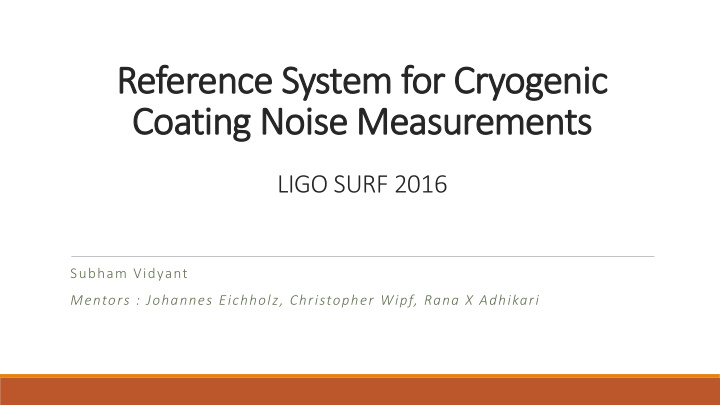



Reference System for Cryogenic Coating Noise Measurements LIGO SURF 2016 Subham Vidyant Mentors : Johannes Eichholz, Christopher Wipf, Rana X Adhikari
Advanced LIGO Noise Budget
A Simple Model of Coating Noise Brownian Noise :- 𝑙 𝐶 𝑈(1−𝜏 2 ) 2 1−2𝜏 𝜚 𝑑𝑝𝑏𝑢 𝑒 𝑇 𝑦 𝑔 = 𝜌 3/2 𝑔𝑥𝐹 𝜚 𝑡𝑣𝑐𝑡𝑢𝑠 1 + 𝜌 1−𝜏 𝜚 𝑡𝑣𝑐𝑡𝑢𝑠 𝑥 Scales with temperature. Isn’t a fundamental limiting noise. Cryogenically cooling test masses is very difficult : No convection, minimal conduction.
Using Silicon instead of Fused Silica Fused silica has bad loss angle at low temperatures. Silicon has low loss angle. But has large thermo-elasticity at room temperature. Can be overcome using cryogenics. Coefficient of thermal expansion has two zero crossings. Absorption is too high at 1064nm (Nd:YAG lasers). 1550nm is used due to wide availability.
Rundown of Experiment Test cavities are short. Beam is narrow. Enhances the effect of coating noise and conversion from length to frequency fluctuations. Coating noise is random. Differential frequency fluctuation measurement gives a direct measure.
Modifications to Experiment Laser bandwidth issue : new current drivers and feedback controllers. Second generation test cavities planned to be only several cm short. Have large free spectral ranges in the GHz range. Differential measurement difficult : resonant frequencies may be too far apart. Solution : Addition of an external reference system. Also used for testing new current drivers.
Goals of SURF Project Assemble and characterize the reference system. Provide ~500 μ W of stabilized laser output to the cryo-bench via an optical fiber.
Gaussian Beams Electric Field :- 𝑦 −𝑠 2 𝑠 2 𝑭 𝑠, 𝑨 = 𝐹 0 𝑥(𝑨) 2 𝑓𝑦𝑞 −𝑗 𝑙𝑨 + 𝑙 2𝑆(𝑨) − 𝜔(𝑨) Two Parameters : Beam Waist and location of Beam Waist.
Optical Cavities Length and end test masses determine parameters of supported beam. They are mode selective. Cavity Visibility : Fraction of total light transmitted which is in 00 mode.
Reference Cavity Length = 20.3 cm Mirror 1 = Plane Mirror Mirror 2 = Concave Mirror (ROC = 50 cm) Supported Mode :- Beam Waist = 348.2 μ m Located at the surface of the plane mirror.
Laser Mode Characterization
Pound – Drever – Hall Sidebands are added to laser using EOM (Elector-Optic Demodulator). The error signal is fed back to the laser current drives as modulation after proper signal conditioning.
Optical Setup
Cavity Transfer Function Cavity Pole ≈ 52 kHz Finesse ≈ 5000 Visibility = 98.57%
Loop Gain -3dB point ≈ 157 kHz
Fiber Coupling Efficiency Solid State Fiber Coupled Lasers. Final light must be coupled into a fiber and transferred to the cryo bench. Output Intensity = 1.8 mW Light intensity exiting fiber Coupling efficiency = Light intensity entering fibre ≈ 26%
Summary & Outlook Characterised Laser and Cavity. Obtained required resonant mode. Placed cavity in position and optimized beam for maximum transmission. Set up feedback loop and obtained a stable lock. Placed Vacuum Tank and made final adjustments to feedback settings. Characterised loop and coupled light into fibre. Next Step :- Pump vacuum tank. Determine noise floor.
Acknowledgment The successful completion of this presentation and the overall project was made possible with the immense help and guidance received by me from my mentor Dr. Johannes Eichholz. I would also like to express my gratitude to Christopher Wipf Rana X Adhikari
THANK YOU
Recommend
More recommend